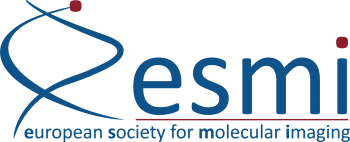Congratulations
The PhD Award for excellent PhD thesis 2013/2 goes to Hans Wehrl from Tübingen for his thesis on “Possibilities and limitations of combined PET/MR imaging in oncological and neurological basic research”.
Possibilities and limitations of combined PET/MR imaging in oncological and neurological basic research
Abstract
Aim of this work was to evaluate the possibilities and limitations of combined positron-emissiontomography (PET) and magnetic-resonance (MR) imaging, which are two medical imaging technologies revealing complementary information in vivo. Combined PET/MR allows using the high sensitivity of PET-imaging to depict molecular, metabolic and functional processes in conjunction with the excellent soft tissue contrast and the functional imaging capabilities of MR. The potential applications of combined PET/MR were demonstrated in four different studies. This cumulative dissertation is based on two accepted publications, as well as on further parts that are not published.
In the field of oncology a murine brain tumor model was evaluated. Here the aim was to demonstrate the relationship between choline metabolism measurements performed by [11C]choline-PET and choline MR spectroscopy (MRS). In this study it was shown that [11C]choline-PET mainly depicts parts of the tumor tissue with a high choline turnover connected to cell membrane synthesis, whereas the MRS technique yields areas of high endogenous choline concentration, indicating also tumor spread and gliosis. Therefore both methods are in some cases spatially and metabolically complementary. The in vivo imaging data were supplemented by histophathological correlations using immunohistochemistry, messenger riobnucleic acid (mRNA) expression using real-time polymerase chain reaction (rt-PCR) and secondary-ionmasspectrometry.
This combination of methods was so far not described in literature and proved the unique potential of combined PET/MR to reveal the multifacetted nature of choline metabolism in tumors. Limitations in the quantification of MRS data, caused e.g. by magnetic field inhomogeneities, need to be addressed in future studies.
The study of brain function using different stimuli is an emerging field that is not only impacting neuroscience itself but also spreads into multiple disciplines like psychology and other areas. Currently most of the studies to image brain function are performed using functional MRI (fMRI) utilizing the blood oxygen level dependent (BOLD) contrast. However, only a few studies have so far addressed the interrelationship between BOLD-fMRI and PET imaging. Therefore in healthy rats the glucosemetabolism was assessed during brain activation using the PET tracer [18F]2-Fluor-2-deoxy-D-glucose ([18F]FDG) and at the same time applying BOLD-fMRI. The primary activation foci were identified quantitatively and simultaneously in both modalities, PET and fMRI. However, in certain areas of the brain a high change of glucosemetabolism was identified during stimulation, where a change in BOLD signal could not be observed. This points towards processes that are too slow and too small in signal change to be depicted by BOLD imaging, but also to a possible decoupling of glucosemetabolism and oxygen or flow dependent signal in certain brain regions. Furthermore, dynamic PET data was evaluated for the first time in small animals using an independent component analysis (ICA). Results yielded regions in the brain, that have a similar PET tracer uptake behaviour. Some of these regions were also identified in an ICA of the fMRI data. These findings indicate the possibility to map functional connectivity inside the brain using PET methods and therefore to depict metabolic networks in the brain. These new findings in the animal brain, were demonstrated for the first time in this work, and show a huge potential in the realm of neuroscience. The half life of 109.8 min of the PET tracer [18F]FDG poses some limitations on the experimental design.
To image fast changes in brain function the PET perfusion tracer [15O]H2O with a half life of 122 s is more suitable. In a combined PET/MR experiment [15O]H2O -PET and BOLD-fMRI during brain activation were compared. Qualitatively both methods showed similarities in the identified activated regions in the brain. However when comparing the location of the activation maxima a spatial offset on the order of 2.5±1.4 mm was found. Moreover fMRI showed in general larger and more statistical significant activations. The spatial offset can be attributed to the different physiological origin of both signals. The [15O]H2O-PET signal arises from changes in the arterial space as well as capillary bed, whereas the BOLD-fMRI signal, using the gradientecho method is, more weighted towards the draining veins. The offset in statistical significance and
volume stems from the fact that a typical fMRI experiment acquires far more imaging data per stimulation condition compared to PET. The results indicate that especially for the planning of surgical interventions in the brain the discrepancies between PET and MR need to be taken into account and can be assessed using combined PET/MR.
PET/MR allows also to cross-calibrate different quantitative imaging methods. Perfusion can be assessed on the one hand using [15O]H2O -PET but also on the other hand using arterial-spin-labelling (ASL) MRI. In a combined PET/MR experiment perfusion was simultaneously assessed in mice using both PET and MR. At high perfusion rates, above approximately 100 mL/min/100g a deviation between the two methods was found, with the tendency of [15O]H2O -PET to measure lower values compared to ASL. One possible explanation for these phenomena is the limited permeability of the blood-brain-barrier for radioactive water. Other effects such as the exact determination of an arterial input function, the choice of the kinetic model, or imaging artefacts, caused by geometrical distortions and slight changes in slice positioning due to
MR system frequency changes, cause challenges for further studies. This work was able to show in the respective studies for the first time the potential of combined PET/MR to yield complementary information about metabolism and function. In the field of oncology as well as neurology this work shows results that have not been described so far. Besides the development of novel, combined acquisition strategies and data evaluation techniques this work also required numerous
measurements and the solution of many technical challenges, of which some still remain. In general it could be shown that PET/MR has a huge potential to revolutionize medical imaging in research as well as in clinical diagnosis.
Impact of my thesis by Hans Wehrl
The thesis is a compelling example evaluating the strengths of multimodal PET/MR imaging. The main impact of this PhD research is to show the complimentary nature of PET and MRI. I.e. not one technique is replacing another one, but both techniques can together yield new insights into function and metabolism.
First part: [11C]Choline-PET vs. MRS (Cancer Research 2013)
- The comparison of MRS and [11C]Choline-PET show the complimentary nature both imaging modalities to track choline metabolism in murine brain tumors
- The in vivo brain tumor data is cross validated using secondary ion mass spectrometry (SIMS) imaging.
- This is one of the first studies using this innovative method (besides histology and mRNA expression) for validation.
- Second part: [18F]FDG-PET vs. BOLD-fMRI (Nature Medicine 2013)
Second part: [18F]FDG-PET vs. BOLD-fMRI (Nature Medicine 2013)
- The in vivo brain activation study using simultaneous [18F]FDG-PET and BOLD-fMRI is the first study using PET/MR to simultaneously investigate brain function
- It is the first study using this new technology to obtain glucose metabolism data on a slow time scale and at the same time BOLD data on a fast time scale
- It is the first comparision of simultaneously acquired brain activation data during stimulation, minimizing the influence of confounding effects such as repositioning, changes in physiology etc
- It is the first functional connectivity fMRI study (“resting state fMRI”) performed with a small animal PET/MR device
- It is the first application of independent component analysis to dynamic brain PET data to obtain correlated brain networks
- It is the first comparision of brain networks obtained at the same time with PET and MR in the same subjects.
Third part: [15O]H2O-PET vs. BOLD-fMRI (NeuroImage in minor revision)
- The in vivo brain activation study using [15O]H2O-PET imaging is the first study showing these brain activation maps using PET in small animals.
- It is the first comparision study of [15O]H2O-PET and BOLD in small animals
- The study indicates a mismatch between these two brain mapping methods
- The discovered results point towards a complimentary nature of both techniques
Fourth Part: [15O]H2O-PET vs. ASL-MRI
- This is the first simultaneous PET/MR study comparing quantitative perfusion values from the “gold standard” [15O]H2O-PET with the emerging arterial spin labelling MR method.
- The PET technique appears to underestimate perfusion values at higher blood flow values (above 100 ml/min/100g)
- This mismatch can be traced back to the limited blood-brain-barrier permeability for radioactive water.
Hans Wehrl on his future career plans
“My further career plans are to pursue more detailed research in combined PET/MR neuroimaging. With a special focus on functional and metabolic brain imaging and connectivity. Especially exploiting the large amount of complimentary data offered by PET and MR but also amending it with additional information e.g. from MEG or quantumbiological measurements offers huge opportunities to explore brain function. Ultimately I would like to establish my own research group in the field of function-metabolic brain connectivity mapping, with possible spin offs of the developed methods also to fields like oncology.”

“Hans has done a tremendous job in pushing forward PET/MR research. His endurance and patience to solve problems, as well as his unique ingenuity and innovation deserve respect and greatly exceed my expectations. In his excellent and outstanding thesis Hans covers three major topics using PET/MR in the fields of oncology and neurology […].
Bernd Pichler – supervisor
The impact of Hans’ thesis on the field of multi modality imaging is from my point of view tremendous. I think the most important part is, that he clearly shows that PET/MR is not only the combination of molecular information from PET with anatomy from MR, but that the strength is in the utilization of the functional imaging capabilities of both modalities. Also the translation of his work into humans is currently ongoing by our group but also at other institutions.
Hans currently plans to further investigate brain networks by means of functional and metabolic imaging based on PET and MR. He is currently developing methods of complex network analysis as well as CMRO2 measurements using radioactive gases and calibrated BOLD. I have no doubt that Hans will be successfully in his work, and can ultimately establish his own research group.”
Hans’ publications related to his thesis
Simultaneous PET-MRI reveals brain function in activated and resting state on metabolic, hemodynamic and multiple temporal scales
Nature Medicine
Assessment of rodent brain activity using combined [15O]H2O-PET and BOLD-fMRI
NeuroImage
